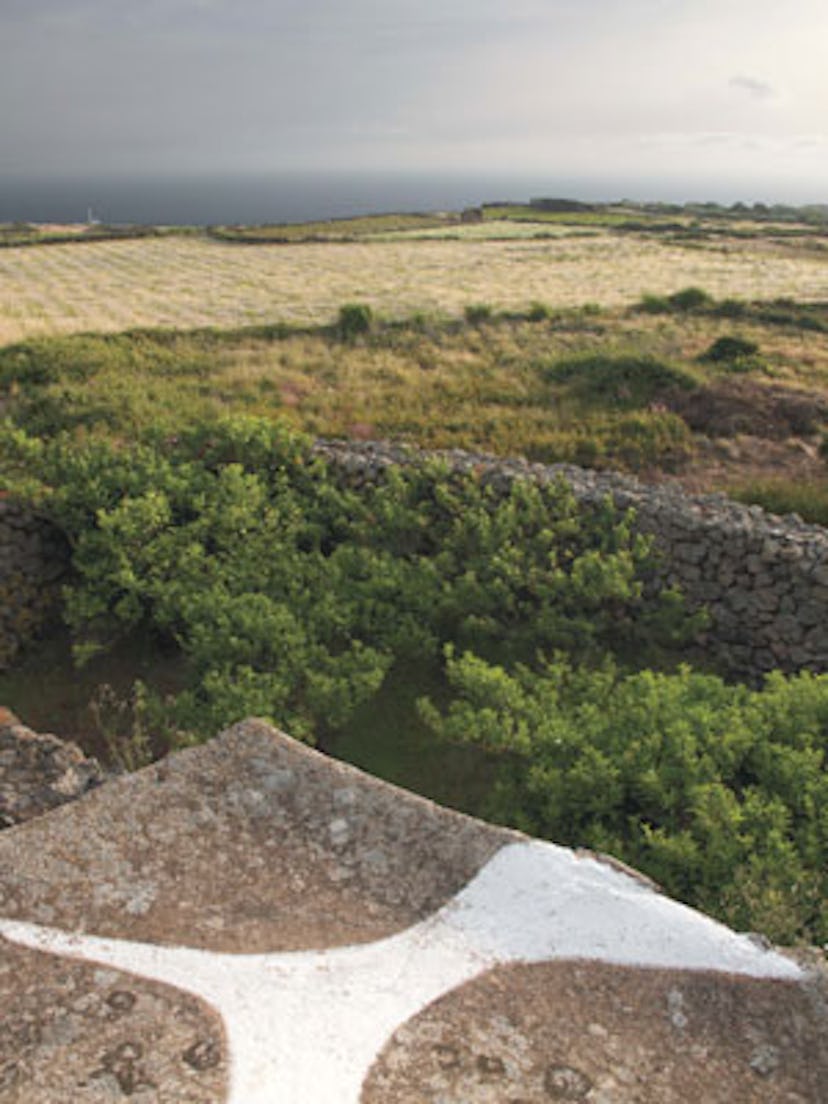Fabrizio Ferri is a resourceful man. This became clear on a morning this past May, when a small gang of travelers, en route to visit the well-known fashion photographer on the Sicilian island of Pantelleria, found themselves stranded at the Palermo airport. Among the group was Ferri’s ex-wife, interior designer Barbara Frua De Angeli, who was laden down with six huge boxes of decorative items meant to serve as the finishing touches on a makeover of Monastero, the jewel-box resort that Ferri owns on the island. When the announcement came that flights were canceled due to high winds on Pantelleria, Frua De Angeli frantically called Ferri. “Don’t worry, I’ll find you a boat,” he promised. But as it turned out, bad weather made travel by sea impossible too. And, to further complicate matters, ash from the Icelandic volcano was rapidly floating toward Italy, bringing with it the possibility that Palermo’s airport might have to shut down. Ferri, however, remained undaunted and soon called with a solution: He had intercepted a pilot he knew who was flying nearby and convinced him to make a detour. Within an hour, the travelers were roller-coastering their way through gales of wind in the only mechanical device to reach Pantelleria for the next three days.
Ferri, 57, a larger-than-life creature with a salt-and-pepper beard and feline green eyes, has a long history of bringing the seemingly impossible to fruition. And nowhere has this ability served him more handily than on Pantelleria. Twenty-two years ago he bought an entire village of derelict homes on the island and turned them into a luxe, hugely atmospheric lodging. In the time since, jetsetters, artists and even a few one-named celebrities (Sting and Madonna, to be exact) have come to stay at Monastero; earlier this year, Ferri further upped the chic quotient with a major renovation and expansion.
Ferri first visited Pantelleria in 1985. “I was living in Milan and needed a place that was exotic enough to shoot fashion photographs, but not too far away,” he recalls. “A friend mentioned Pantelleria and I had never heard of it, but I decided to give it a try.”
The “daughter of the wind,” as Pantelleria is known, is certainly exotic. Though the island belongs to Italy, it’s actually much closer to Africa, 43 miles from the Tunisian coast. Grapevines, olive groves and wildflowers abound, cropping up among sharp-edged black lava rocks. “I was taken by the unique quality of the light and the intensity of the landscape,” Ferri says.
He was also taken by the island’s traditional architecture. Pantelleria’s rural houses, called dammusi, are cavelike, with thick walls, small windows and domed roofs. By the time Ferri arrived, most were in a sorry state, having been traded for modern apartments. The photographer, however, immediately saw their charm. “By the time I got back to Milan,” he says, “the keys to my first dammuso were rattling in my pocket.”
That was just the beginning. In 1988, while exploring the wilds of the island, he found himself standing amid a hamlet of long-empty dammusi. Within months, he’d purchased the village from a local family. “I felt the urge to save these testimonies to human resourcefulness and transform them into something I could share with others,” he says. To aid him in that endeavor, Ferri turned to Gabriella Giuntoli, a Milanese architect who had arrived in Pantelleria for a short trip in the summer of 1966 and never left. Her philosophy: “Even if slightly crooked, a handmade wall of stones from the fields is infinitely more beautiful than concrete.”
The result of Ferri and Giuntoli’s collaboration was Monastero, an intimate resort with six sparsely furnished, whitewashed guest rooms. Before long, the place was overflowing with creative types. In the mid-Nineties Sting spent a month at Monastero while working on Mercury Falling. But the most fortuitous guest, at least for Ferri, arrived in 1996. Alessandra Ferri, a renowned ballerina who just happened to share a surname with the photographer, was invited to visit by her friend Isabella Rossellini, who was working on a shoot with Ferri. “I went and suddenly my whole life changed,” says Alessandra, with whom Ferri now has two daughters. The couple live in New York but visit Monastero as frequently as possible. “It is the only place I know where one feels absolutely connected to one’s own creativity,” says Alessandra.
Two years ago, however, Ferri noticed that Monastero was looking a little careworn. Alessandra suggested they ask Frua De Angeli, who was married to Ferri in the early Eighties and has a grown daughter with him, to restyle the place. “Barbara is part of the family,” says Alessandra. “She knows what we like and what we need.”
Working side by side with Giuntoli and Giuntoli’s son, Andrea, Frua De Angeli reimagined the guest quarters, designing nine unique rooms, some with private gardens, others with frescoes, and all with large baths and shaded verandas. Gem-toned linens, antique beds and sculptural lamps mix with sleek, modern consoles and the occasional African textile. Three of the rooms are in additional dammusi adjacent to the village that Ferri bought in 2006.
In between dips in the pool and excursions to nearby archaeological sites, guests feast on local food and Passito, the sweet Pantellerian wine. Despite the renovations, however, Ferri was careful to maintain Monastero’s ancient charm, hiding all wiring underground and shunning standard conveniences like televisions, telephones and minibars. “I wanted to show that it was possible to bring new life to these old stones without erasing the patina of age,” he says. “The greatest accomplishment here is not so much what you do see but what you don’t.”
